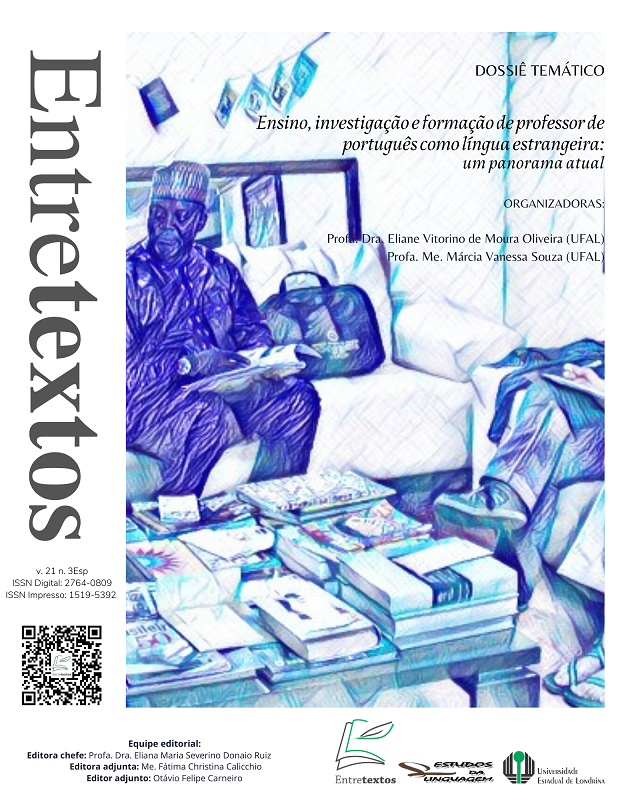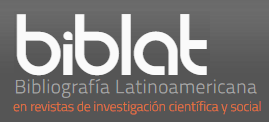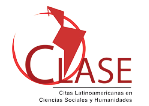Desvios colocacionais em português língua estrangeira
DOI:
https://doi.org/10.5433/1519-5392.2021v21n3Esp.p218Palavras-chave:
Colocações, Interlíngua, Português Língua EstrangeiraResumo
Este artigo objetiva discutir os desvios colocacionais evidenciados em produções textuais em Português Língua Estrangeira (doravante PLE), como forma de revelar as hipóteses levantadas pelos aprendizes acerca do funcionamento da língua portuguesa. Em nossos referenciais teóricos, destacamos os estudos sobre colocações, na perspectiva fraseológica, em Sinclair (1991), Lewis (2000, 2012), Bahns (1993) e Tagnin (2013), o conceito de competência colocacional de Lewis (2000), Wu (2003) e O'Dell e McCarthy (2008), e os cinco processos de interlíngua de Selinker (1974), Henderson (1985) e Tarone (2006). Nossa metodologia contempla cinco propostas de produções de texto, do gênero e-mail, cujo teor aborda as perspectivas dos participantes sobre aspectos culturais brasileiros, como a culinária e os pontos turísticos. Os participantes, por sua vez, são oito norte-americanos que desenvolveram atividades de promoção da língua inglesa no Brasil por nove meses em 2015. As produções textuais dos participantes foram analisadas, as ocorrências de desvios colocacionais identificadas e classificadas conforme os seus níveis de proficiência, a saber B1/B2 e C1/C2. Os dados revelaram que os desvios são, em sua maioria, motivados pelos processos de transferência linguística e de emprego equivocado de elementos verbais e nominais, e mais recorrentes nos níveis mais avançados de proficiência em PLE.
Downloads
Referências
BACHMAN, Lyle. Habilidad lingüística comunicativa. In: LLOBERA, Miquel. (org.). Competencia comunicativa: documentos básicos en la enseñanza de lenguas extranjeras. Madrid: Edelsa, 1995. p. 105-127.
BAHNS, Jens. Lexical collocations: a contrastive view. ELT Journal, Oxford, v. 11, p. 56-63, 1993.
BRITTO, Luiz Percival Leme. A sombra do caos: ensino de línguas x tradição gramatical. São Paulo: Mercado de Letras, 1997.
BUTLER-TAKANA, Paul. Fossilization: a chronic condition or is consciousness-raising the cure? 2000. 93p. Dissertation (Master's in Arts) - Faculty of Arts, University of Birmingham. Birmingham, 2000.
CANALE, Michael. De la competencia comunicativa a la pedagogía comunicativa del lenguaje. In: LLOBERA, Miquel. (org.). Competencia comunicativa: documentos básicos en la enseñanza de lenguas extranjeras. Madrid: Edelsa, 1995. p. 63-81.
CARTER, Ronald. Vocabulary: applied linguistic perspectives. London: Routledge, 1987.
CONSELHO EUROPEU. Quadro Europeu Comum de Referência para as línguas: aprendizagem, ensino e avaliação. Lisboa: Edições ASA, 2001.
CORDER, Stephen Pit. Idiosyncratic dialects and error analysis. In: RICHARDS, James Clifton (org.). Error Analysis: Perspectives on Second Language Acquisition. London: Longman, 1974a. p. 158-171.
CORDER, Stephen Pit. The significance of Learners' Errors. In: RICHARDS, James Clifton (org.). Error analysis: perspectives on second language acquisition. London: Longman, 1974b. p. 19-27.
FIRTH, May B. Interlanguage theory: implications for the classroom. McGill Journal of Education, Montréal, v. 13, n. 2, p. 155-165, 1978.
FILLMORE, Charles J. Innocence: a second idealization for linguistics. Proceedings of the Berkeley Linguistics Society, Berkeley, v. 5, p. 63-76, 1979.
GASS, Susan M.; SELINKER, Larry. Second Language Acquisition: an introductory course. New Jersey: Lawrence Erlbaum, 1994.
GOMES, Marcela de Lima. As noções do termo erro para os estudos linguísticos e suas implicações ao ensino de língua portuguesa. 2016. 117p. Dissertação (Mestrado em Educação) - Instituto de Ciências da Educação, Universidade Federal do Oeste do Paraná. Paraná, 2016.
HENDERSON, Michael M. T. The notion of interlanguage. Journal of Modern Language Learning, Kansas, v. 21, p. 23-27, 1985.
HUNDT, Christine. Construções de verbo + substantivo: estrutura, semântica e posição dentro da fraseologia. Verbo e estruturas frásicas. Rev. Fac. de Letras - Línguas e Literaturas, Porto, p. 267-275, 1994.
HYMES, Dell Hathaway. On communicative competence. In: PRIDE, J. B.; HOLMES, J. (org.). Sociolinguistics: selected readings. Harmondsworth: Penguin, 1972. p. 269-293.
JUNIOR, Valdson José Santana; PINTO, Marie Jolly Nascimento; SANTANA, Robson Ferreira. Erro(s): Entre o desvio e a norma. V Colóquio Internacional "Educação e Contemporaneidade". São Cristóvão, p. 1-16, 2011.
LEWIS, Michael. Teaching collocations: further developments in the lexical approach. Hove: Language Teaching Publications, 2000.
LEWIS, Michael. The lexical approach: state of ELT and a way forward. 4th ed. London: Language Teaching Publications, 2012.
LLOBERA, Miquel. Una perspectiva sobre la competencia comunicativa y la didáctica de las lenguas extranjeras. In: LLOBERA, Miquel (org.). Competencia comunicativa: documentos básicos en la enseñanza de lenguas extranjeras. Madrid: Edelsa, 1995, p. 5-26.
MAIA, Francisca Paula Soares. O "erro" linguístico a partir de uma perspectiva sociolinguística laboviana. In: V CIEL - CICLO DE ESTUDOS EM LINGUAGEM. Estudos da Linguagem e Formação Docente: desafios contemporâneos. UEPG - Ponta Grossa, Paraná, 28 a 30 de abril, 2009.
O'DELL, Felicity; McCARTHY, Michael. English collocations in use, advanced: how words work together for fluent and natural English. Cambridge: Cambridge University Press, 2008.
SAVIGNON, J. Sandra. Communicative Competence: Theoretical and Classroom Practice. Reading: Addison-Wesley Publishing, 1983.
SELINKER, Larry. Interlanguage. In: RICHARDS, James Clifton (org.). Error analysis: perspectives on second language acquisition. London: Longman, 1974. p. 31-54.
SILVA NETTO, José William. Desenvolvimento da competência colocacional na produção escrita dos assistentes de professores de inglês em universidades brasileiras. 2016. Dissertação (Mestrado em Linguística) - Universidade Federal do Ceará, Centro de Humanidades, Fortaleza, 2016.
SINCLAIR, John. Collocation. Corpus, concordance, collocation. Oxford: Oxford University Press, 1991.
TAGNIN, Stella E. O. O jeito que a gente diz: combinações consagradas em inglês e português. São Paulo: Disal, 2013.
TARONE, Elaine. Interlanguage. Amsterdam: Elsevier, 2006.
WU, Wen-shuenn. A quantitative study of university students' collocational competence in an ESP context. ESP Malaysia, Malaysia, v. 9, p. 95-119, 2003.
Downloads
Publicado
Como Citar
Edição
Seção
Licença
Copyright (c) 2021 Entretextos

Este trabalho está licenciado sob uma licença Creative Commons Attribution 4.0 International License.
Entretextos adota a Licença Creative Commons Attribution 4.0 International, portanto, os direitos autorais relativos aos artigos publicados são do/s autor/es.
Sob essa licença é possível: Compartilhar - copiar e redistribuir o material em qualquer suporte ou formato. Adaptar - remixar, transformar, e criar a partir do material, atribuindo o devido crédito e prover um link para a licença e indicar se mudanças foram feitas.
























